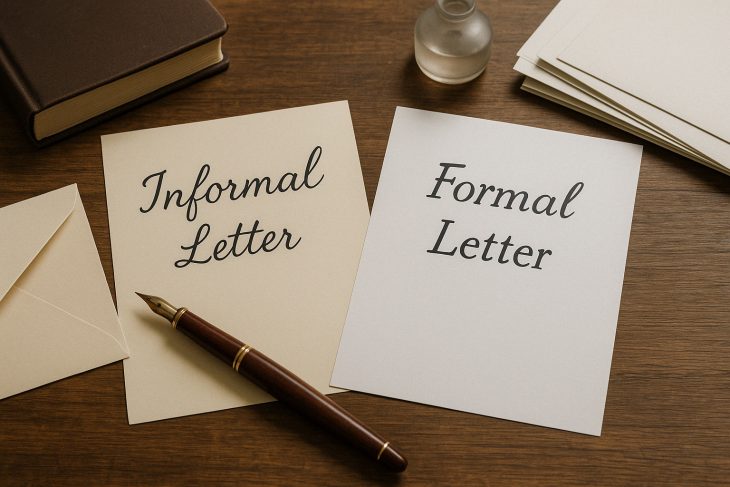
Communication through the written word has long played an important role in human society. From personal letters between friends and family to formal business correspondence, the ability to convey information, ideas and emotions through writing remains a valuable skill. Keep reading to examine the main distinctions between informal and formal letters and when each format is appropriate.
Informal Letters
An informal letter is a personal letter written to a friend, family member or other close acquaintance. The language used in informal letters is casual and conversational. Writers often use colloquialisms, slang, nicknames and other relaxed forms of address when writing to people they know well.
Content covers personal life details, stories, jokes, hopes, worries – anything that nurtures relationships. The tone is intimate, candid and heartfelt. Writers share confidential information and seek empathy, advice and mutual understanding.
Informal letters do not require a strict structure. Paragraphs tend to be short, with frequent line breaks. The overall look of the page feels open and varied. Writers meander loosely between topics as thoughts occur. Headings are rare. There is no need to organise rigidly or watch formality. Letter writers can be themselves, speak freely and value connection over polish.
The purpose is to bridge physical distance, deepen intimacy, provide comfort or simply enjoy the companionship of someone dear through written dialogue. Informal letters tend to be relatively unplanned, spontaneous and free-flowing. This makes them well-suited for expressing emotions honestly and strengthening bonds between close correspondents.
Formal Letters
In contrast to informal letters, formal letters follow set conventions and employ formal language. The tone is polished, respectful and universally appropriate. Formal letters have a clearly defined structure, including an introduction, logically ordered body paragraphs and a conclusion.
The language avoids slang, idioms or cultural references that the recipient may not understand. Carefully chosen vocabulary and correct grammar are used throughout. The style follows established rules for formal business, academic or professional writing.
Content covers topics related to official needs or work. The tone is polite, dignified and reserved. Writers remain focused on the primary purpose without sharing personal details. Factual information is presented accurately and concisely without strong emotions.
Formal letters serve business, organisational or official purposes. Common examples include cover letters for job applications, business correspondence, complaints, and letters to government agencies or public officials. The goal is to communicate ideas or information clearly, efficiently and in a professional manner.
As a result, formal letters require planning and care. The organised structure ensures the letter meets its purpose and follows accepted conventions. Clear section headings and paragraphs focus on each topic. The language remains clear and well-defined at all times. Following established guidelines helps convey respect for the recipient and their time.
Key Differences
The key differences between informal and formal letters include:
- Purpose – Informal letters aim to connect with friends/family personally, nurture relationships, and share details of one’s personal life, thoughts and feelings. Formal letters serve official business/organisational needs, convey factual information professionally, and accomplish a specific purpose.
- Tone – Informal letters use a warm, intimate, candid tone, sharing confidential details and seeking empathy. Formal letters have a polite, dignified, reserved tone focused on facts.
- Language – Informal letters use casual, conversational language like slang, idioms, abbreviations, nicknames and trendy phrases. Formal letters use proper vocabulary, standard accepted grammar and writing conventions appropriate for professional communications.
- Structure – Informal letters loosely jump between personal topics with minimal organisation. Formal letters contain structured sections, clear focus and logic to achieve their purpose.
- Formatting – Informal letters have flexible formatting like handwriting, doodles, and creativity. Formal letters adhere to standards like typed text, proper letterhead, and formal presentation.
- Content – Informal letters cover personal topics freely with details of one’s life and inner thoughts. Formal letters focus on facts strictly related to the official purpose.
- Planning – Informal letters are often spontaneous with little editing or refinement. Formal letters require care in planning, drafting and precision.
- Relationship – Informal letters nurture close personal relationships between friends/family. Formal letters maintain formality, professionalism and distance.
The written word allows us to communicate ideas and feelings in various contexts. Distinguishing between informal and formal letters enables us to engage with recipients appropriately. When writing to close friends and loved ones, informal letters nurture relationships through sincerity and openness. Formal letters respect conventions to convey information accurately and professionally. Choosing the correct format helps writers connect with readers, meeting their emotional or practical needs through the enduring power of letter writing.
Was this page helpful?
Our commitment to delivering trustworthy and engaging content is at the heart of what we do. Each fact on our site is contributed by real users like you, bringing a wealth of diverse insights and information. To ensure the highest standards of accuracy and reliability, our dedicated editors meticulously review each submission. This process guarantees that the facts we share are not only fascinating but also credible. Trust in our commitment to quality and authenticity as you explore and learn with us.


